ARCHITECTURAL REVIEW
12 February, 2014
The philosophy of Green In-Flows
Ιn the presentation of Greek participation in 24th World Congress of Architecture, as part of Region II with vice president Lisa Siola_Tokyo, September 2011.
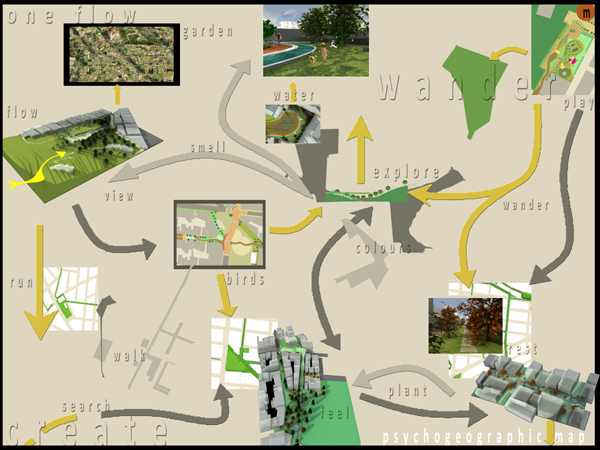
Psychogeographic map of one in-flow.
"Architecture is the simplest way of articulating the relation between space and time, to organize reality, to realize dreams, to achieve not only formal expressions of a temporal beauty, but a regulation that is engraved in the eternal curve of human wants and the achievements on the route to their realization" Guy Debord, Ιnternationalle Situationniste, The Overcome of Art, Documents before the establishing of S.I., G.Ioannidis (transl), Ypsilon, Athens, 1999
A.why green?
We live in a time where a constant mutation of society is in effect, whose roots can be traced to the industrial revolution. The global population has tripled in the span of a century, and during the last 60 years, 50% of the earth's habitants live in urban centers, a trend that shows no signs of slowing down. This extreme concentration of population and infrastructure led to an architecture of congestion, a very culture of congestion, the metropolis.
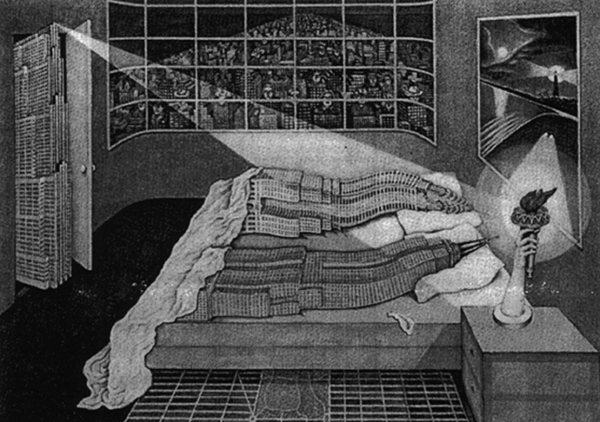
"The culture of Congestion".
We all know what a metropolis is.A living organism with uncertain limits, both spatially and socially that is in a state of perpetual growth. The successor to the metropolis is the metapolis, followed by the diffused city . Nevertheless, the problems inherent in this mode of dwelling are multiple and remain, despite the transformations of the city environment. The social relations are not governed by the values of pre metropolitan life, but produced and dictated by the contemporary political and economical framework.
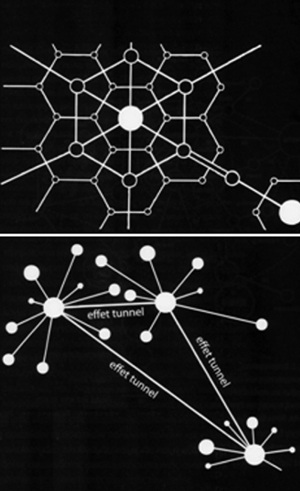
" Crystaller Network with hierarchical city structure", "«Metapolitical» network with centers").
The bourgeois city dweller of the 20th century, according to Walter Benjamin is the flaneur[2] described by Baudelaire: a soulless human being, wandering around the city as part of an anonymous mass of commuters. Zimmel describes the blasé[3] as simultaneously indifferent and nervous, looking for some source that will excite him. At the same time, Adorno and Horkheimer attempt to investigate the reason why western civilization, despite its scientific and technological progress was not able to build a world free from hunger, war, misery and oppression. The answer, according to them lies in the decline of the theoretical conscience and the total domination of material and technical progress over nature. The very concept of progress is mutated into the means of controlling and manipulating the very way of thinking and ultimately the way of living.
It can be argued that "the most serious problems of modern life stem from the difficulty of the individual to retain his autonomy and individuality in the face of crushing social forces, the historic legacy, the environment and the process of daily life" G.Simmel,"City and Soul", G.Lykiardopoulos (transl.), Erasmos, Αthens, 1993.p.13.
One important consequence of this co-existence between the social and the individual at such a large scale is the lack of "living space" a factor that is coupled with an equally severe lack of "green space". Today, either because of the prevalent economical policies or the absence of urban planning strategies, cities develop in a haphazard and oppressive manner and "Nature has been limited to isolated islands in a sea of buildings" as Paulos Lefas says in "Without Limits". The natural is replaced by the artificial And as a result man is in many cases unable to make the distinction between what is truly natural and what an artificial substitute[4].

«Comparison of Green and Bicycle Roads in Athens and Europe».
"Man has tamed nature in such a way that nowadays he experiences the effects of unbridled urbanization in its purest form" Μurray Bookchin, The Limits of the City, G. Dalianis (transl.), Free Press, Athens, 1979.
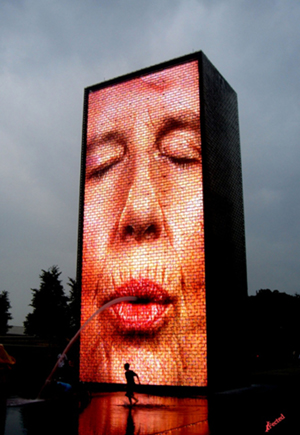
«Artificial mother nature».
To satisfy the needs of the above processes, we are forced to destroy the environment, in which we live, severely compromising our natural habitat. Oxygen levels are dropping, temperature is rising, the atmosphere becomes ever more polluted, the cities are flooding and harmful emissions are increasing by the year.
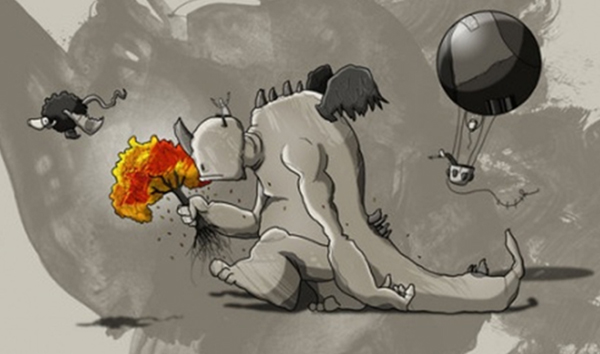
«Dejected Monster, Jason Gurley».
But what really is a metropolis?
«Cities are bastions of freedom, focal points of freedom» Jean luc Pinol
Metropolis is a word of greek origin, a synthesis of the words mitra and poli, which means matrix and city. The metropolis by definition is the space in which values, ideas, civilization and science are born. It is the milieu in which creation and art reach their zenith. The question that arises is why is the contemporary urban environment- in which we live- so far from this ideal? What are the reasons for the predominance of the negative aspects of urban life? Why can't urban centers be viable, clean and healthy?
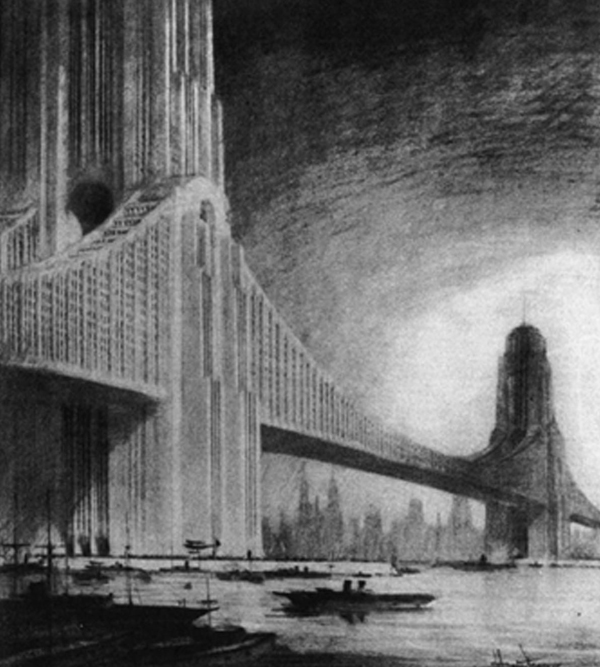
«The metropolis of Tomorrow», Hugh Ferriss, 1929.
Historically, many urbanists and architects tackled this problem and attempted to find way to re-integrate nature with the urban and human environment, while at the same time reconfiguring the socioeconomic processes of production . We all know the Broadacre City of Frank Lloyd Wright, the Contemporary city of Le Corbusier or the Garden City of Ebenezer Howard. The common theme in these attempts is the focusing on small groups of individuals and the communal organization in harmony with the natural environment.
B) Why Ιn-flows
This distorted evolution of the city also creates inconsistencies in the urban fabric, a fact that also affects the green spaces of the city. It can be argued that public space as a whole is in the process of a qualitative transformation that is reflected in a transformation in the collective unconscious, as well as conscious thought, bringing to the forefront characteristic such as passivity, isolation and estrangement. Guy Debord in 1968, faced with the estranged and scared citizens of the spectacle society, proposes the concept of the "playful man"(homo ludens) who, free from petit bourgeois perceptions and neuroses is free to wander, playing and, free co-creating his life with his neighbours.
A green grid...
It is, therefore, possible to simultaneously view as a whole and as autonomous entities, different areas of the city and treat them as small communities. Green spaces in a city are Places of meeting, socializing, playing, creating , places of love, solidarity and also a better way of working. A worker living in a healthy (green) environment is more likely to be more efficient and competent in his work. Also, green spaces offer a different aesthetic, oxygen, a cleaner atmosphere, natural materials, gardens, playgrounds as well as allowing the growing of food on a small communal scale.
The change in the living environment, brings to the forefront new emotional conditions, that range from the initial passive acceptance to more conscious and constructive immersions. Τευχος 3 I.S.
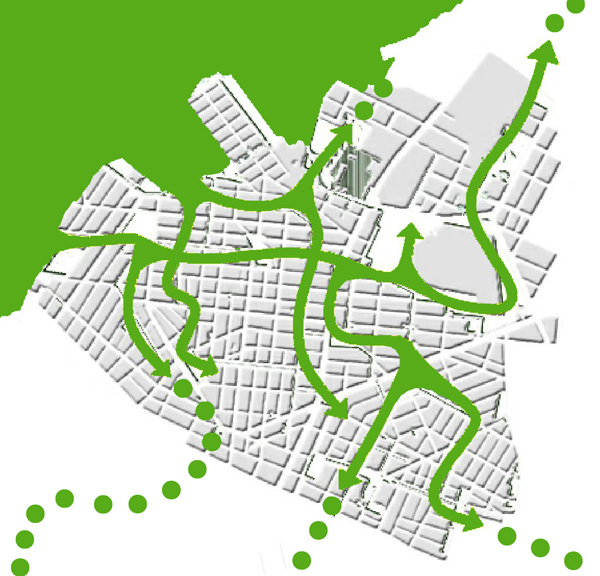
«Geen in-flows" M.M.Siouti.
Inflows from parks, pedestrian routes, bicycle ways,gardens and vegetable plots are integrated in the urban grid in a nonstop flow and become part of it, serving the functional needs of the city but also being spaces of wandering, through paths without beginning or end. Nature is no longer present in a fragmented and haphazard fashion , as a foreign body in the urban tissue, but as an integral part of the living organism of the city. In this organic urban fabric, the conditions for participation, interaction and contact are met, favoring the reestablishment of man's relation with nature as well as his fellow ,man. These are conditions that allow the emergence of the "experiential" and "psychogeography".
In between towering skyscrapers, continuous natural spaces can create a two speed environment. Trees and the resulting biodiversity will ameliorate the sonar and optical pollution of the urban environment. In the end, nature herself reestablishes and retakes her role in the life of the urban dweller.
Environmentally speaking, the advantages of such a project are multiple. The conditions of a holistic, bioclimatic approach to urban living, are met. Cities become independent form traditional and polluting forms of energy such as oil and nuclear power. Green urban centers are the starting point for a sustainable and self sufficient habitat. In this way the long term creation of an enormous green web that would cover the entire city can be envisioned. The necessary knowledge and technical means for such a project are available to us, what remains is the process of transition.
It is a general truth that Greece is in the grip of a big crisis that is not only economical but social too. Furthermore, this crisis is not limited to Greece but is spreading through domino phenomena to the whole of Europe, as well as America and Asia. The present situation, therefore, calls for architects to give solutions to immediate issues through design projects on a practical as well as a conceptual level. Thus, the value of the public space, as a medium of socialization, interaction and solidarity is more important than ever.
Is this a Utopia?
utopia : u + topos = non place
eutopia : eu + topos = blisfull place
In greek the origin utopia comes from the words (outopia: ou+topos which means non place) is only one word away from the word eutopia:ey+topos, which means blisfull place.
The dream begins in reality and is realized in reality.
by Melani - Maria Siouti
Pictures
- Psychogeographic map of an in-flow, M.M.Siouti, September 2011
- Rem Koolhaas "The Culture of Congestion", G.Aesopos(transl), («Life in the Metropolis or The Culture of Congestion», Architectural Design 47, no 5, August, 1997)
- "Crystaller Network with hierarchical city structure" - "«metapolitical» network with centers"), A.Gospodini, H.Beriatos, The New urban Landscapes and the Greek City, Kritiki, Athens, May, 2006, p. 107
- «Comparison of Green and Bicycle Roads in Athens and Europe", M.M.Siouti, September 2011
- Artificial Mother Nature, 2005, http://ifected.devianart.com/
- Dejected Monster, Jason Gurley http://my.qoop.com/store/Jason-Gurley-9667377954444676/Dejected-Monster-copy-jpg-qpps_126186230142138/
- The metropolis of Tomorrow, Hugh Ferriss, 1929 http://www.mexicanpictures.com/headingeast/2006/03/metropolis-of-tomorrow.html
- "Green In-Flows", M.M.Siouti, general plan, September 2011
[1] According to the meaning of «metropolis-metapolis-diffuce city» there is an extensive analysis in the Research Project: Siouti Maria Melanie "Man - Nature - City", chapter D, Univercity of Patras, 2007,p.126
[2] «Some Motifs in Beaudelaire", Walter Benjamin, Sarl Beaudelaire : A lyric in the development of Capitalism, K.Livieratos, L.Anagnostou, G.Gouzoulis (transl), Aleksandreia,Athens,1994,p.167
[3] G.Simmel,"City and Soul", G.Lykiardopoulos (transl.), Erasmos, Αthens, 1993.
[4] Reference to M.M.Siouti, "Man - Nature - City", chapter D
[5] Reference to M.M.Siouti, "Man - Nature - City", chapter C
[6] Homo ludens: playful man, an origin in Ιnternationalle Situationniste, The Overcome of Art., G. Ioannidis(transl), Ypsilon, Athens, 1999
Related articles:
- The philosophy of Green In-Flows ( 12 February, 2014 )
- Green in-flows ( 09 November, 2012 )










